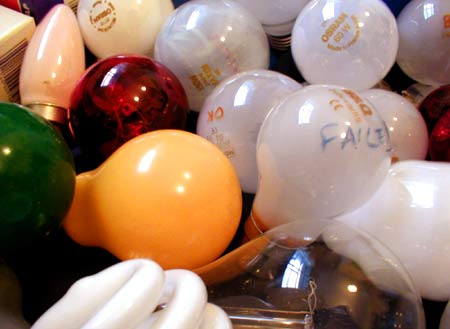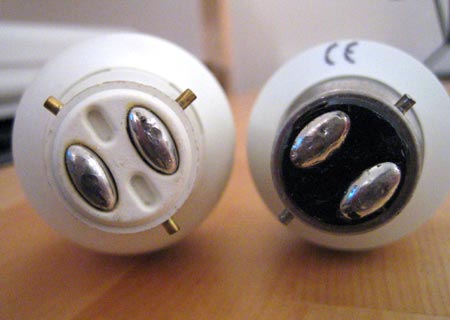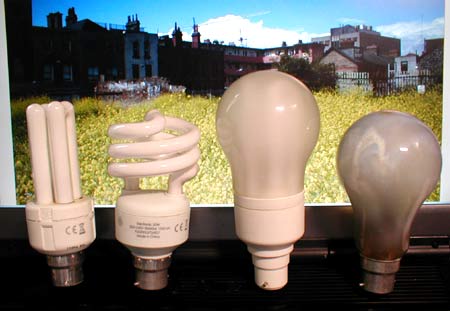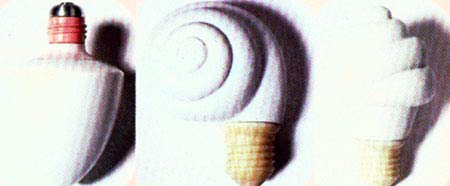
UPDATE: See this more recent post for information and photos of how to get a 2-pin bulb to fit in a BC3 fitting.
BC3 reactions
The post looking at the Eaton MEM BC3 system, a couple of months ago, has become something of a reference for UK householders and renters trying to work out why they can’t fit a normal 2-pin bayonet compact fluorescent (or other bulb) in the light fittings of their new house or flat – or so I assume from some of the search strings in the server logs.
Some comments from readers highlight the frustration and inconvenience caused by the 3-pin system – and in these cases it’s people trying to use CFLs in the fittings. They’re trying to be energy-efficient, trying to comply with government advice indeed, yet a combination of ill-thought-out regulations and a razor-blade-style commercial lock-in architecture of control is preventing their success. As an example of ‘reducing the environmental impact of products by using design to change user behaviour‘, the BC3 seems to be a poorly thought-out initiative.

Increasing CFL uptake
Elsewhere, on the subject of CFLs, Duncan Drennan of The Art of Engineering blog has a very informative post looking at aspects of the CFL argument, such as comparing colour rendering indices, which are less often addressed in media articles on the subject. As Duncan makes clear – even including a spreadsheet to calculate the savings – the monetary arguments in terms of electricity saved are probably a more direct way to persuade many people than using environmental arguments.
Duncan also mentions the higher-end CFLs such as the Osram Dulux Superstar (which has a quicker start-up time to full brightness than standard CFLs). Along with CFLs which are shaped more like conventional incandescent bulbs (such as the version of the Osram Duluxstar, third from left in the first photo below), or even with more interesting forms, such as the concepts by Dutch designer Jacob de Baan (second image below), these surely have the potential to convert more householders to CFLs: the standard 3 U-tube design is rather ugly.


Above: Some types of CFL (from left: Tesco Value, GE Elegance and Osram Duluxstar) lined up next to a burned-out incandescent bulb. Note that the Osram Duluxstar – basically a standard 3 U-tube CFL with a bulb-shaped cover – is taller than even the 150W incandescent, due to the space taken up by the ballast, and this extra length can be a problem when using CFLs in existing light fixtures, shades, etc. Some companies, such as Sylvania with its Mini-Lynx Ambience range, have addressed this by making CFLs with shorter tubes and ballast such that the whole thing is the same size as a standard incandescent bulb. Below: Three CFL concepts by Jacob de Baan. Apologies for the scan quality (the images are from The Eco-Design Handbook, 2004 edition, by Alastair Fuad-Luke).
Power Factor
A rarely mentioned issue with CFLs which I realised recently (courtesy of a letter by Andrew Porter in The Engineer, a UK journal), is that of power factor. Not having studied electricity generation for some time, this is something I’d shoved to the back of my mind, but essentially it results from the phase shift between voltage and current caused by a reactive (capactive or inductive) load as opposed to a purely reactive one, and means that the actual power supplied by the power station (in volt-amps) will be greater than that indicated by simply looking at the wattage (in watts), where reactive loads are involved.
A normal incandescent filament bulb is an almost entirely resistive load, and the voltage and current will be in phase (hence a power factor of 1). But a CFL – with a significant proportion of capacitive load due to the ballast – will have a much lower power factor, perhaps only 0.5. This means that a ’15W’ CFL actually requires 30VA from the power station – which the private customer will not pay for directly, since home electricity meters only measure watts, but it is still equivalent to needing to supply double the power. That increase in necessary generation can’t be ignored: the consumer will pay for it one way or another.
Rod Elliott has a detailed examination of why the power factor should certainly be taken into account when looking at CFLs in a policy context and it’s very much worth reading for a better understanding of the issue. While fluorescent lighting ballasts with high power factors (0.95+) are available (in industrial situations, a large customer will often have to pay for the actual VA drawn by large reactive loads, such as motors), they are unlikely to be incorporated any time soon into mass-produced cheap CFLs. Elliott suggests that because fluorescent lighting is so often left on continuously (partly because of the belief that it will last longer if not switched on-and-off), in conjunction with the power factor issue, mass adoption of CFLs may actually increase the electricity used.
I don’t know to what extent policy-makers have taken the power factors of cheap CFLs into account when planning mass conversion initiatives, but in the long run, it would seem that LED home lighting (without a power factor issue), perhaps with DC ring-mains to prevent the need for multiple transformer/rectifiers, is a better solution than total adoption of CFLs.